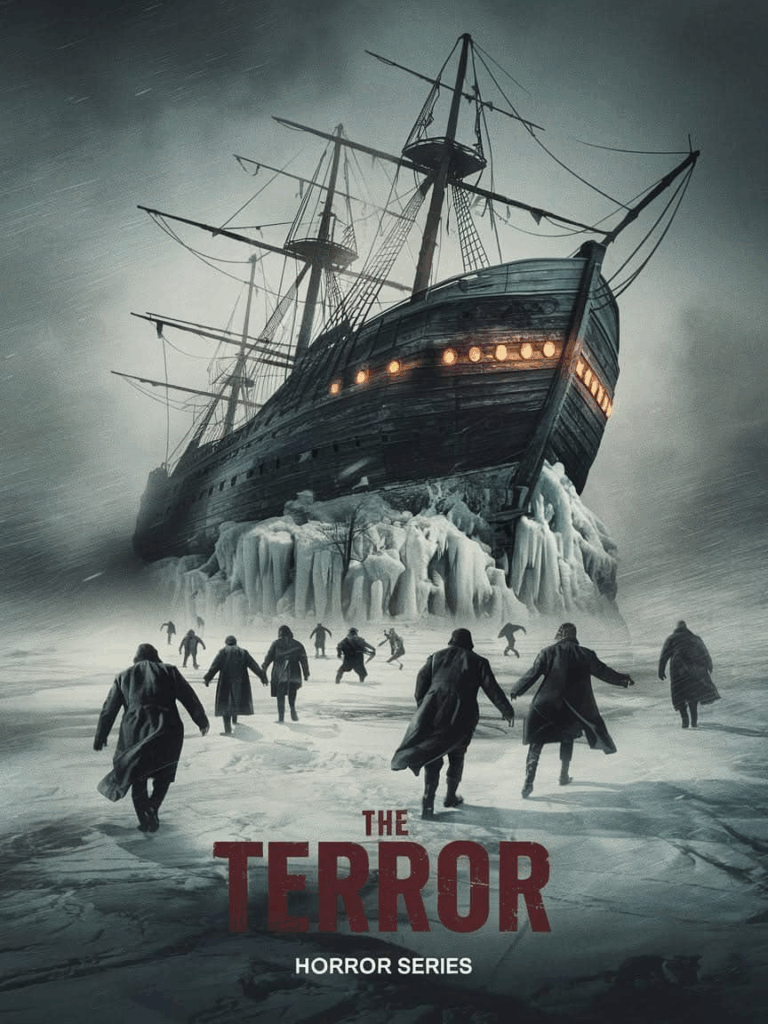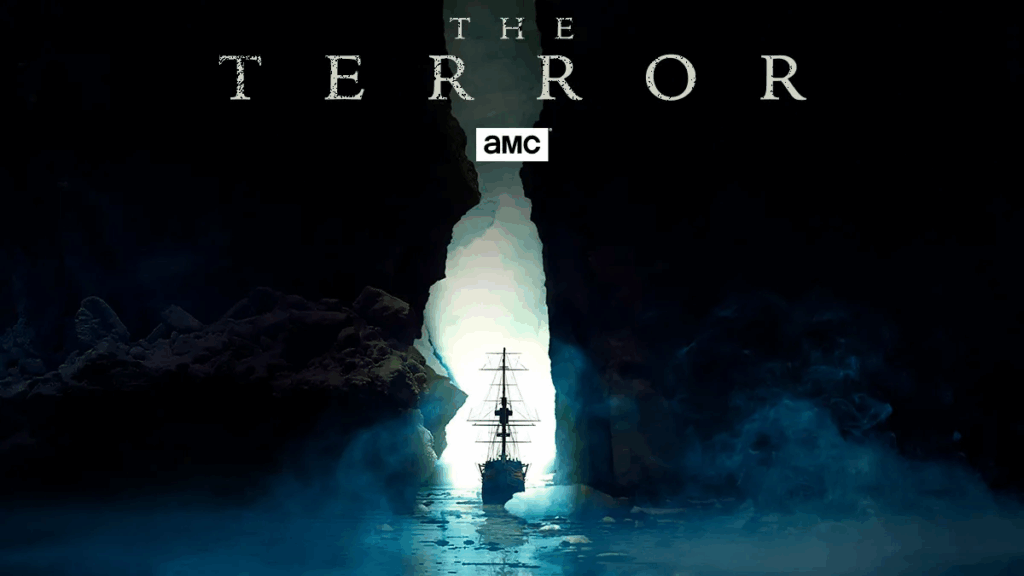The Terror (2018-2025)


Introducing The Terror (2018–2025): AMC’s Chilling Horror Anthology Series
Overview
The Terror (2018–2025) is an American supernatural horror drama anthology series developed for AMC, blending historical events with speculative fiction and chilling horror elements. Each season draws inspiration from real-life tragedies, weaving tales of human struggle, survival, and the supernatural. The first season, based on Dan Simmons’s 2007 novel The Terror, premiered on March 25, 2018, and dramatizes the doomed 1845–1848 Franklin Expedition to the Arctic. The second season, The Terror: Infamy, premiered on August 12, 2019, and explores Japanese-American internment during World War II. A third season, The Terror: Devil in Silver, based on Victor LaValle’s novel, is set to premiere in 2025, focusing on a man wrongfully committed to a psychiatric hospital. With a TV-14 rating and episodes averaging 60 minutes, The Terror has garnered critical acclaim for its atmospheric storytelling, stellar performances, and haunting production design. This article provides a comprehensive exploration of the series’ plot, cast, production, themes, reception, and cultural significance, highlighting its unique place in modern television.

Plot Summary
Season 1: The Terror (2018)
Set in 1847, the first season fictionalizes the ill-fated Franklin Expedition, led by Captain Sir John Franklin (Ciarán Hinds), to find the Northwest Passage. Two Royal Navy ships, HMS Erebus and HMS Terror, become trapped in Arctic ice, stranding 129 men in a brutal, frozen wasteland. Captain Francis Crozier (Jared Harris), commander of HMS Terror, and Commander James Fitzjames (Tobias Menzies) of HMS Erebus navigate dwindling supplies, scurvy, lead poisoning from canned food, and the unraveling morale of their crew. A monstrous polar bear-like creature, the Tuunbaq, stalks the men, blending Inuit mythology with supernatural horror. The season explores survival, leadership, and human desperation, culminating in a tragic yet poignant resolution. Key characters include Dr. Harry Goodsir (Paul Ready), a compassionate surgeon, and Cornelius Hickey (Adam Nagaitis), a cunning caulker’s mate whose ambition fuels mutiny.

Season 2: The Terror: Infamy (2019)
Set during World War II, Infamy follows Chester Nakayama (Derek Mio), a Japanese-American photographer, and his family in a California internment camp after the attack on Pearl Harbor. A series of bizarre deaths plagues their community, tied to a malevolent shape-shifting spirit, Yuko (Kiki Sukezane), rooted in Japanese folklore. Chester, alongside his girlfriend Luz (Cristina Rodlo) and father Henry (Shingo Usami), grapples with racism, cultural identity, and the supernatural force haunting them. The season intertwines historical trauma with horror, exploring themes of displacement and resilience, though it received mixed reviews for its pacing and narrative focus.

Season 3: The Terror: Devil in Silver (2025)
Announced in February 2024, the third season adapts Victor LaValle’s novel The Devil in Silver. It centers on Pepper (Dan Stevens), a working-class man wrongfully committed to New Hyde Psychiatric Hospital, where he faces societal outcasts, institutional neglect, and a mysterious entity. The six-episode season, written by LaValle and Chris Cantwell, promises a blend of psychological horror and social commentary, with a cast including Judith Light, CCH Pounder, and Aasif Mandvi. Directed by Karyn Kusama for the first two episodes, it is set to premiere in 2025, continuing the anthology’s tradition of merging real-world issues with supernatural dread.

Cast and Characters
The series boasts a robust ensemble across its seasons. In Season 1, Jared Harris delivers a standout performance as Crozier, a pragmatic yet haunted leader, while Ciarán Hinds portrays Franklin’s hubris-driven command. Tobias Menzies shines as the charismatic but flawed Fitzjames, and Paul Ready’s Goodsir offers a moral anchor. Adam Nagaitis’s Hickey, a scheming antagonist, is a fan favorite for his chilling complexity. Nive Nielsen plays Lady Silence, an Inuk woman pivotal to the Tuunbaq’s mystery, with casting efforts ensuring cultural authenticity.
Season 2 features Derek Mio as Chester, whose emotional journey grounds the narrative. Kiki Sukezane’s Yuko is both tragic and terrifying, while George Takei, as Nobuhiro Yamato, brings gravitas as a community elder, drawing from his own internment camp experiences. Cristina Rodlo and Shingo Usami add depth to the Nakayama family’s struggles.
For Season 3, Dan Stevens leads as Pepper, supported by a diverse cast including Judith Light, CCH Pounder, Chinaza Uche, and Aasif Mandvi, promising a fresh dynamic for the anthology’s psychological horror. The series’ commitment to strong casting enhances its emotional and historical weight.

Production and Direction
Developed by David Kajganich for Season 1, with Soo Hugh as co-showrunner, The Terror was produced by Scott Free Productions, Emjag Productions, and AMC Studios, with Ridley Scott among the executive producers. Season 1’s 10 episodes were filmed in Hungary, using CGI to recreate the Arctic’s icy expanse, with meticulous set design evoking 19th-century shipboard life. Directors included Edward Berger and Tim Mielants, with cinematography by Kolja Brandt capturing the claustrophobic dread.
Season 2, co-created by Max Borenstein and Alexander Woo, shifted to Vancouver for filming, recreating internment camps with historical accuracy. Directors like Josef Kubota Wladyka and Lily Mariye brought a distinct visual style, though the season faced criticism for uneven pacing.
Season 3, under writers LaValle and Cantwell, is in production, with Karyn Kusama directing, signaling a return to the series’ high production values. The anthology format allows each season to reinvent itself, maintaining a cohesive tone of dread and historical grounding.

Themes and Style
The Terror excels in blending historical drama with supernatural horror, exploring themes of survival, isolation, and the human cost of ambition. Season 1 delves into colonialism, hubris, and the clash between European explorers and Indigenous cultures, with the Tuunbaq symbolizing nature’s wrath. Its slow-burn tension, punctuated by visceral horror, evokes comparisons to Alien and Twin Peaks.
Infamy tackles racism, cultural identity, and intergenerational trauma, using the yurei spirit to mirror the dehumanization of Japanese-Americans. Its horror is more psychological, though some felt the supernatural elements clashed with the historical narrative.
Devil in Silver is expected to address mental health stigma, institutional failure, and societal neglect, with horror rooted in psychological and supernatural ambiguity. The series’ visual style—claustrophobic interiors, desolate landscapes, and period detail—creates an immersive atmosphere, enhanced by scores from composers like Max Richter (Season 1).

Reception and Legacy
Season 1 received widespread acclaim, earning a 94% rating on Rotten Tomatoes and a 76/100 on Metacritic, with critics praising its “gripping, atmospheric supernatural horror” and “commandingly acted” ensemble. Forbes called it “one of the best series of 2024” upon its Netflix release, highlighting its historical and horror blend. Some viewers found the Tuunbaq subplot divisive, preferring a straight historical drama, but its slow-burn suspense and tragic climax were widely lauded.
Season 2, Infamy, was less universally praised, with a 75% Rotten Tomatoes score. Critics appreciated its ambition and performances, particularly Takei’s, but found the pacing uneven and the horror less integrated. User reviews on IMDb reflect this divide, with Season 1 averaging 9/10 and Season 2 closer to 2/10 for some, though others valued its cultural commentary.
The series’ legacy lies in its bold anthology format, tackling diverse historical tragedies with a horror lens. Its influence is evident in works like The Ministry of Time (2024), inspired by Season 1’s Graham Gore. Available on Netflix, AMC+, Amazon Prime, and Shudder, The Terror has found a global audience, with Season 3 poised to continue its tradition of sophisticated horror.

Cultural and Historical Context
The Terror emerged during a resurgence of prestige horror on television, alongside The Haunting of Hill House (2018) and American Horror Story. Season 1 reflects renewed interest in the Franklin Expedition, following the 2014 and 2016 discoveries of HMS Erebus and HMS Terror, which added historical weight to its fictionalized narrative. Its portrayal of Inuit culture, while fictionalized, was informed by consultation with Inuk advisors, addressing colonial legacies sensitively.
Infamy resonates with contemporary discussions of racial justice, drawing parallels to modern xenophobia and historical redress for internment survivors. George Takei’s involvement lent authenticity, grounding the season in lived experience. Season 3’s focus on mental health aligns with growing awareness of institutional reform, promising relevance in 2025’s social climate.
The series’ global release, including early Amazon Prime availability in select countries, reflects the streaming era’s reach, though VPN use for geo-restricted access highlights modern viewing challenges.

Conclusion
The Terror (2018–2025) is a masterful anthology series that blends historical tragedy with supernatural horror, delivering gripping narratives and unforgettable performances. From the Arctic’s frozen desolation in Season 1 to the internment camps of Infamy and the psychiatric wards of Devil in Silver, the series explores humanity’s darkest fears with intelligence and atmosphere. Jared Harris, Antonio Banderas, and the upcoming Dan Stevens lead stellar casts, supported by meticulous production values and bold storytelling.
Available on Netflix, AMC+, Amazon Prime, and Shudder, The Terror is a must-watch for fans of historical drama and horror alike. As it prepares for its third season in 2025, the series continues to captivate with its ability to unearth the terrors of the past while speaking to the present, cementing its place as one of television’s most compelling anthologies.Play